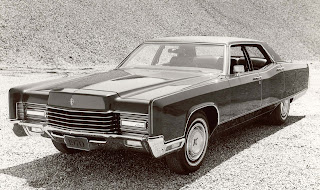Plymouth Barracuda
The Lincoln Continental is an automobile which was produced by the Lincoln division of Ford Motor Company from 1939 to 1948 and again from 1956 to 2002. Despite often sharing underpinnings with less-expensive Fords in more recent years, the Lincoln Continental had usually been a distinctively platformed and styled, highly equipped luxury car in the course of its long history.The flagship Lincoln model during most of its run, the Continental name conveyed special cachet in the product line. During the 1980s, the Continental was downsized from a full-size to a mid-size Ford Taurus platform; this introduced the Continental to a wider range of competition from Europe and Japan. After the Continental was discontinued in 2002, it was largely replaced by the Lincoln LS and eventually the Lincoln MKS.
For 1970, the Continental received a ground-up redesign for the first time since 1961. Available again as a two-door hardtop and a four-door pillared hardtop, the Continental borrowed a number of styling cues from both its predecessor and the Continental Mark III. As before, the sides were relatively unadorned with blade-like fenders, but the door handles on 4-doors gave away the biggest change: the distinctive "suicide doors" were replaced by conventional front-hinged doors. Like the Mark III, the Continental now wore hidden headlamps. Unibody construction was replaced by cheaper body-on-frame construction; on the upside, the old rear leaf springs were replaced by coil springs.
Another major change to the Continental lay under the skin; for the first time, it shared a common platform with the full-size Ford LTD and Mercury Marquis. The 1970 model was the first time ever a standard Lincoln shared a chassis with the full-sized Fords, somewhat expected as the Ford in LTD form had increasingly marketed itself as a "poor man's Lincoln" in the late 60s. "In essence, the new Lincoln was to the Ford and Mercury what the General Motors C-Body offerings (especially the Cadillac) were to the medium priced car lines that employed the B-shell."
In mid-model year 1972, Lincoln's long history of distinct engines from its corporate counterparts came to an end as the 460 V8 became available in the Mercury Marquis and Colony Park. To move upmarket from Ford and Mercury, the full-size Lincoln product line gained two nameplates with two popular option packages. In 1970, the Town Car name (dormant since 1959) was revived; in 1973, a corresponding two-door Town Coupe was introduced. In addition to the standard Continental, the Town Car/Town Coupe offered a limousine-style vinyl top and more standard equipment. Front disc brakes were standard.
During its lifecycle, this generation of Continental saw a number of changes. From 1970 to 1974, each model year wore a different grille style. In 1973 and 1974, the Continental (to comply with federal mandate) was fitted with 5-mph bumpers in the front and rear, respectively. In comparison to the 1970 model, the 5-mph bumpers seen on 1975–1979 models left the Continental 7 inches longer.
For 1975, the 2-door hardtop model was replaced with a pillared coupe; the 4-door received a new roofline to further differentiate it from Ford and Mercury models. The Continental Town Coupe received a square opera window in its C-pillar while the Town Car received an oval one (similar to the Mark IV). Braking performance, a sore point on full-size American cars of the time, was improved as the Continental became one of the first American cars (besides the Corvette) with 4-wheel disc brakes.
Lincoln Navigator
In 1977, the grille changed from a rectangular unit to the Rolls-Royce radiator grille seen on the Mark Series; variations of this style would be used on the Continental and Town Car until 1997. The new grille was both higher and narrower than in previous years, but the position of the headlamps remained unchanged. To hold the line on price and to increase fuel economy, previously standard luxury features gradually became optional over the decade, with the 460 cu in (7.5 L) engine becoming an option in 1978, replaced in 1979 by the 400-cubic-inch (6.6 L) engine as standard. Rear fender skirts were removed for the 1978 model year. Four-wheel disc brakes were optional.By 1979, the Continental measured 233.0 in (5,920 mm) and weighed between 4,900–5,500 lb (2,200–2,500 kg) depending on the year. After General Motors downsized its full-size product lineup for 1977, the Continental became the largest mass-market automobile produced worldwide at the time, surpassed only by purpose-built limousines such as the Mercedes-Benz 600 and Rolls-Royce Phantom VI. The 460 cid V8 was also the largest-displacement engine in any production car worldwide from 1977 to 1978.
- wikipedia.org -
Der Lincoln Continental ist ein Automobil, das durch den Lincoln-Division von Ford Motor Company von 1939 bis 1948 und erneut von 1956 bis 2002 produziert wurde. Trotz der oft gemeinsam mit Unterbau weniger teure Fords in den letzten Jahren hatte der Lincoln Continental in der Regel eine deutlich platformed und gestylt, hochwertig ausgestattete Luxus-Auto im Laufe seiner langen Geschichte.
La Lincoln Continental est une automobile qui a été produite par la division Lincoln de Ford Motor Company de 1939 à 1948 et de nouveau de 1956 à 2002. Malgré partageant souvent fondements avec moins coûteuse Ford dans les années plus récentes, la Lincoln Continental avait en général été un distinctement platformed et de style, voiture de luxe très bien équipées dans le cadre de sa longue histoire.














No comments:
Post a Comment